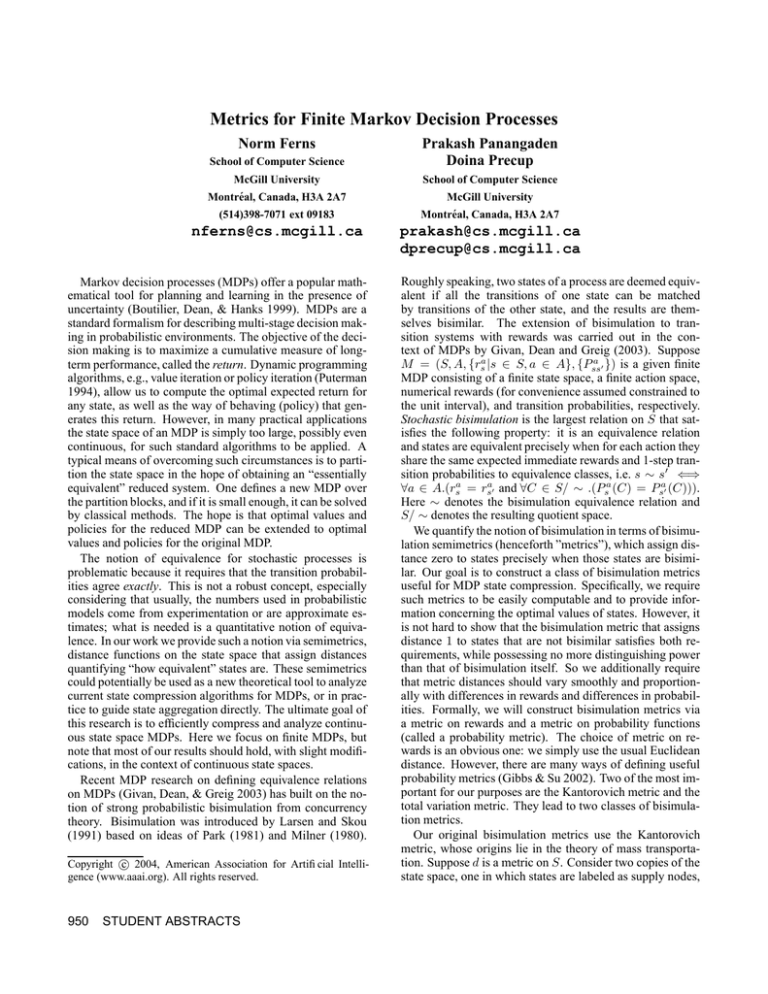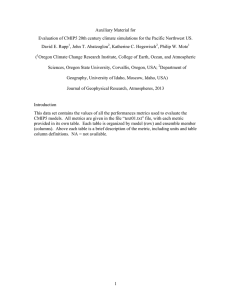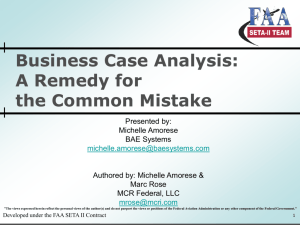
Metrics for Finite Markov Decision Processes
Norm Ferns
School of Computer Science
Prakash Panangaden
Doina Precup
McGill University
School of Computer Science
Montréal, Canada, H3A 2A7
McGill University
(514)398-7071 ext 09183
Montréal, Canada, H3A 2A7
nferns@cs.mcgill.ca
prakash@cs.mcgill.ca
dprecup@cs.mcgill.ca
Markov decision processes (MDPs) offer a popular mathematical tool for planning and learning in the presence of
uncertainty (Boutilier, Dean, & Hanks 1999). MDPs are a
standard formalism for describing multi-stage decision making in probabilistic environments. The objective of the decision making is to maximize a cumulative measure of longterm performance, called the return. Dynamic programming
algorithms, e.g., value iteration or policy iteration (Puterman
1994), allow us to compute the optimal expected return for
any state, as well as the way of behaving (policy) that generates this return. However, in many practical applications
the state space of an MDP is simply too large, possibly even
continuous, for such standard algorithms to be applied. A
typical means of overcoming such circumstances is to partition the state space in the hope of obtaining an “essentially
equivalent” reduced system. One defines a new MDP over
the partition blocks, and if it is small enough, it can be solved
by classical methods. The hope is that optimal values and
policies for the reduced MDP can be extended to optimal
values and policies for the original MDP.
The notion of equivalence for stochastic processes is
problematic because it requires that the transition probabilities agree exactly. This is not a robust concept, especially
considering that usually, the numbers used in probabilistic
models come from experimentation or are approximate estimates; what is needed is a quantitative notion of equivalence. In our work we provide such a notion via semimetrics,
distance functions on the state space that assign distances
quantifying “how equivalent” states are. These semimetrics
could potentially be used as a new theoretical tool to analyze
current state compression algorithms for MDPs, or in practice to guide state aggregation directly. The ultimate goal of
this research is to efficiently compress and analyze continuous state space MDPs. Here we focus on finite MDPs, but
note that most of our results should hold, with slight modifications, in the context of continuous state spaces.
Recent MDP research on defining equivalence relations
on MDPs (Givan, Dean, & Greig 2003) has built on the notion of strong probabilistic bisimulation from concurrency
theory. Bisimulation was introduced by Larsen and Skou
(1991) based on ideas of Park (1981) and Milner (1980).
c 2004, American Association for Artificial IntelliCopyright gence (www.aaai.org). All rights reserved.
950
STUDENT ABSTRACTS
Roughly speaking, two states of a process are deemed equivalent if all the transitions of one state can be matched
by transitions of the other state, and the results are themselves bisimilar. The extension of bisimulation to transition systems with rewards was carried out in the context of MDPs by Givan, Dean and Greig (2003). Suppose
a
M = (S, A, {rsa |s ∈ S, a ∈ A}, {Pss
0 }) is a given finite
MDP consisting of a finite state space, a finite action space,
numerical rewards (for convenience assumed constrained to
the unit interval), and transition probabilities, respectively.
Stochastic bisimulation is the largest relation on S that satisfies the following property: it is an equivalence relation
and states are equivalent precisely when for each action they
share the same expected immediate rewards and 1-step transition probabilities to equivalence classes, i.e. s ∼ s0 ⇐⇒
∀a ∈ A.(rsa = rsa0 and ∀C ∈ S/ ∼ .(Psa (C) = Psa0 (C))).
Here ∼ denotes the bisimulation equivalence relation and
S/ ∼ denotes the resulting quotient space.
We quantify the notion of bisimulation in terms of bisimulation semimetrics (henceforth ”metrics”), which assign distance zero to states precisely when those states are bisimilar. Our goal is to construct a class of bisimulation metrics
useful for MDP state compression. Specifically, we require
such metrics to be easily computable and to provide information concerning the optimal values of states. However, it
is not hard to show that the bisimulation metric that assigns
distance 1 to states that are not bisimilar satisfies both requirements, while possessing no more distinguishing power
than that of bisimulation itself. So we additionally require
that metric distances should vary smoothly and proportionally with differences in rewards and differences in probabilities. Formally, we will construct bisimulation metrics via
a metric on rewards and a metric on probability functions
(called a probability metric). The choice of metric on rewards is an obvious one: we simply use the usual Euclidean
distance. However, there are many ways of defining useful
probability metrics (Gibbs & Su 2002). Two of the most important for our purposes are the Kantorovich metric and the
total variation metric. They lead to two classes of bisimulation metrics.
Our original bisimulation metrics use the Kantorovich
metric, whose origins lie in the theory of mass transportation. Suppose d is a metric on S. Consider two copies of the
state space, one in which states are labeled as supply nodes,
and the other in which states are labeled as demand nodes.
Each supply node has a supply whose value is equal to the
probability mass of the corresponding state under probability function P . Each demand has a value equal to the
probability mass of the corresponding state under probability function Q. Furthermore, imagine there is a transportation arc from each supply node to each demand node, labeled
with a cost equal to the distance of the corresponding states
under d. This constitutes a transportation network. A flow
with respect to this network is an assignment of quantities to
be shipped along each arc subject to the conditions that the
total flow leaving a supply node is equal to its supply, and
the total flow entering a demand node is equal to its demand.
The cost of a flow along an arc is the value of the flow along
that arc multiplied by the cost assigned to that arc. The goal
of the Kantorovich optimal mass transportation problem is
to find the best total flow for the given network, i.e. the flow
of minimal cost. If we denote by TK (d) the Kantorovich
metric, then the distance assigned to P and Q, TK (d)(P, Q),
is the cost of the optimal flow. It is known to be computable
in strongly polynomial time.
The associated bisimulation metric, df ix , is given by
df ix (s, s0 ) = maxa∈A (cR |rsa −rsa0 |+cT TK (df ix )(Psa , Psa0 ))
where cR and cT are fixed positive weights that sum to 1,
i.e. it is a (unique) fixed-point metric. It is based on similar fixed-point metrics developed in the context of labeled
Markov systems, roughly MDPs without rewards in (Desharnais et al. 1999) and (Desharnais et al. 2002). Like
those, these metrics can be iteratively computed in time
polynomial in the sizes of the state space and the action
space, and can be equivalently formulated in terms of a realvalued modal logic characterizing bisimulation.
An alternative bisimulation metric, d∼ , comes from replacing in the above equation the Kantorovich metric by one
based on the total variation distance. We take the bisimulation
P probability metric TB to be defined as TB (P, Q) =
1
C∈S/∼ |P (C) − Q(C)|. Its calculation involves com2
puting the stochastic bisimulation partition, which can be
done iteratively in polynomial time (Givan, Dean, & Greig
2003). We then define d∼ (s, s0 ) = maxa∈A (cR |rsa − rsa0 | +
cT TB (Psa , Psa0 )).
Both bisimulation metrics assign distances between 0
(bisimilar) and 1 (not bisimilar), giving a measure of “how
bisimilar” two states are. They are related by df ix ≤ d∼
under a pointwise ordering and are in some sense the tightest and loosest smooth bisimulation metrics of the given
form, respectively. Moreover, we can show that the optimal
value function for M , V ∗ , is Lipschitz continuous for each.
Specifically, cR |V ∗ (s) − V ∗ (s0 )| ≤ df ix (s, s0 ) ≤ d∼ (s, s0 )
provided the discount factor γ ≤ cT (Ferns 2003). In particular, this shows that the more bisimilar two states are,
the closer are their optimal values. Such results are extendable to a particular aggregate MDP, allowing us to similarly
bound the difference between the optimal value of a state
in M and the optimal value of its equivalence class in the
aggregate in terms of the bisimulation distances.
Both metrics have advantages and disadvantages. Computation of df ix does not require that the exact bisimulation
partition be computed. Moreover, extending these metrics
to continuous state space models in which rewards are uniformly bounded looks very promising. On the other hand,
iteratively computing the Kantorovich metric (as is required
for the overall computation) while requiring only polynomially many operations is still very time consuming. By
contrast, d∼ is relatively fast to compute (as the bisimulation partition itself can be quickly computed). On the other
hand since its computation relies on computing the exact
bisimulation partition, which is subject to numerical inaccuracy, it may be numerically unstable. Nevertheless, for
these reasons and more we argue that while the Kantorovich
based bisimulation metrics are theoretically pleasing, the total variation based metrics are more pleasing in practice,
and provide empirical results. The bulk of this work can
be found in (Ferns 2003).
References
Boutilier, C.; Dean, T.; and Hanks, S. 1999. Decisiontheoretic planning: Structural assumptions and computational leverage. Journal of Artificial Intelligence Research
11:1–94.
Desharnais, J.; Gupta, V.; Jagadeesan, R.; and Panangaden,
P. 1999. Metrics for labeled markov systems. In International Conference on Concurrency Theory, 258–273.
Desharnais, J.; Gupta, V.; Jagadeesan, R.; and Panangaden,
P. 2002. The metric analogue of weak bisimulation for
probabilistic processes. In Logic in Computer Science,
413–422. Los Alamitos, CA, USA: IEEE Computer Society.
Ferns, N. 2003. Metrics for markov decision processes.
Master’s thesis, McGill University. URL: http://www.
cs.mcgill.ca/˜nferns/mythesis.ps.
Gibbs, A. L., and Su, F. E. 2002. On choosing and bounding probability metrics.
Givan, R.; Dean, T.; and Greig, M. 2003. Equivalence
notions and model minimization in markov decision processes. Artif. Intell. 147(1-2):163–223.
Larsen, K., and Skou, A. 1991. Bisimulation through probabilistic testing. In Information and Computation 94:1–28.
Milner, R. 1980. A Calculus of Communicating Systems.
Lecture Notes in Computer Science Vol. 92. SpringerVerlag. MIL r 80:1 1.Ex.
Park, D. 1981. Concurrency and automata on infinite sequences. In Proceedings of the 5th GI-Conference on Theoretical Computer Science, 167–183. Springer-Verlag.
Puterman, M. L. 1994. Markov Decision Processes: Discrete Stochastic Dynamic Programming. John Wiley &
Sons, Inc.
STUDENT ABSTRACTS 951






